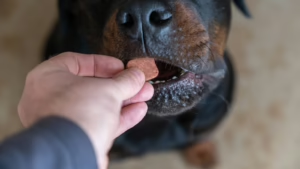“I wanted to be a vet, but I just can’t handle seeing animals in pain.”
I hear this all the time from clients, and I 100% agree. I can’t handle seeing pets in pain. This is probably one of the main reasons I became a veterinarian. In fact, I’d be willing to bet that it is the most common reason that people become veterinarians.
“The prevention and relief of animal suffering” is part of our veterinary oath and one that we at Readivet take extremely seriously. This is why we believe so completely in providing care in your home. We know that it provides relief from the stress of travel or even the pain of travel.
September is Pain Awareness Month, and we wanted to take a minute to discuss the most common types of pain that we see and how we can help relieve that pain in our patients. Because life is rough, most humans understand the different types of pain: chronic pain, acute pain, muscle pain, nerve pain… the list unfortunately goes on. Did you know that animals have all these types of pain as well? As veterinarians, it is our job to determine what type of pain your pet is feeling and how best to alleviate that pain. Sounds kind of hard to do in an animal that doesn’t speak the way we do! However, animals DO speak. Their behavior and movement can speak volumes.
Here are a few of the common ways that our animals can speak to us to tell us they are in pain:
- Decreased Activity
- Decreased Appetite
- Difficulty Standing After Lying Down
- Not wanting to go up or down stairs as readily
- Overgrooming or licking a specific area excessively
- No longer jumping onto surfaces or beds
- Increased vocalization (whining, yelping, grunting when getting up and down)
- Limping
- Shying away from touch or suddenly being anti-social
If you have noticed any of these signs in your pet, it may be pain related. If you have an older pet and have noticed these signs, please do not just attribute it to “old age”. These can be signs of pain related to osteoarthritis that we can help with. If you have a younger animal and have noticed these signs dental disease and soft tissue injury (muscle or ligament issues) can commonly be to blame.
The most common reasons we see pain in animals:
- Dental Disease: Bet you didn’t think I’d list that first! Dental disease is super common in pets of all ages and can cause significant inflammation and chronic pain that can affect a pet’s daily quality of life.
- Joint Pain: Osteoarthritis and Obesity are two of the most common causes of joint pain in pets. Hips, knees, elbows, everything that could hurt on you can hurt on them!
- Muscle Pain: Athlete pets from your agility dogs to jumping cats can develop muscle pain and strain after activity.
- Skin Pain: What? Skin pain? Yes! Pet’s that have allergy issues feel significant discomfort in regards to the constant itching and inflammation of skin.
- Nerve Pain: Inflammation and swelling of any kind can often lead to irritation of nerves triggering an “over-responsive” pain stimulus. This type of pain is specific to how the nerves receive and transmit information and requires a different approach than the types of pain listed above.
So now that we can identify pain in our pets and are familiar with the most common types of pain that we may see in our pets, what can we do about it?
First things first, what is the underlying problem? Obesity? Dental Disease? Allergies? Overuse? The underlying problem will need to be addressed or our attempts to manage and alleviate pain will be much more difficult.
Secondly, we chose appropriate and safe ways to manage pain while the primary issue is being addressed. Thankfully, there are many safe medications that we can use to help decrease pain and inflammation. Also, we can use integrative therapies like acupuncture, cold laser therapy, massage, and rehabilitation exercises. These two avenues often provide significant relief and can allow our pets to return to the quality and comfort of life that they deserve and that we all want for them.
Next we would make a long term plan to manage and resolve the pain. This may include supplements, special diets, rehab exercises that can be done at home, occasional medications or acupuncture. We are fortunate to live in an area that has access to great veterinary support when it comes to integrative therapies, so do not hesitate to ask if you think your pet may benefit from these therapies. We will always work to make a tailored plan that suits you and your pet’s goals and lifestyle.
One quick note about supplements, all supplements are not created equal and there is a lot of hype about certain products (we are looking at you CBD). Before purchasing or using any supplement of any kind on your pet, please reach out to us! We are here to help you make good decisions for your pet!
At ReadiVet we take our veterinary oath to relieve animal suffering very seriously, and we want you to know that we are here to help your pets feel their very best, always. Please do not hesitate to reach out if you feel like your pet may be uncomfortable. Whether young or old, our pets deserve to live pain free and we can help them do that, together.
Helpful Links:
Pain Scale for Dogs: https://ivapm.org/assess-canines-pain-level/
Pain Scale for Cats: https://ivapm.org/assess-felines-pain-level/
Great General Info on Pain and Animals: https://ivapm.org/




